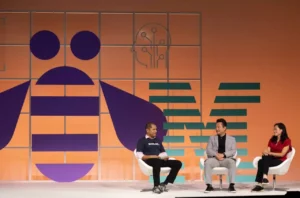
Navigating the intricate realm of modern enterprise applications requires collaboration among diverse personas to effectively manage complexity. This helps with continuous business support through applications automating essential workflows.
Traditionally, applications and their hosting infrastructure align with DevOps and CloudOps. However, rising costs due to diverse IT environments led to the emergence of FinOps, focusing on expense monitoring and control.
Various personas in application deployment have introduced highly complex workflows. Typically, DevOps initiates requests, scrutinized by CloudOps, NetOps, SecOps and FinOps teams. These intricate workflows lead to extended application update times, occasionally impacting business processes and customer satisfaction.
Introduction to Red Hat Services Interconnect
Red Hat Services Interconnect (RHSI), based on the popular open-source project Skupper, aims to simplify the hybrid cloud connectivity needed for applications. It empowers the DevOps teams to get the connectivity that they need, without needing special privileges or without having to depend on complex VPN connections and special firewall rules. This greatly accelerates the application deployment workflow and helps the business users respond with greater agility to the needs of their customers. This also helps in preserving the overall CloudOps and SecOps posture, as it doesn’t ask for new connections to be made at the infra level, or new firewall rules to be added or ports to be opened.
RHSI—the technology beneath
RHSI reduces the dependencies on the L3 layer mechanisms to create application tunnels. Primarily, any L3-based transport will use a VPN mechanism, such as an IPSec tunnel or any other equivalent tunneling mechanisms at L3. These tunnels are to be provisioned and terminated in the routers deployed in the application infra, and hence need to be owned and provisioned by the NetOps and the SecOps teams. As an alternative, RHSI focusses on creating application-level tunnels at a higher layer and uses a well-known messaging infrastructure to transport them at a layer above IP. RHSI employs an open standard application layer messaging protocol. This reduces the dependency on the network layer for creating L3 tunnels for each application, and hence greatly improves the efficiency of the DevOps teams.
In addition, RHSI also is deployed as an “in-cluster gateway”, which means that the gateway is deployed as close to the applications as possible, and therefore can develop a greater awareness about the application environment, as against the traditional routers that are deployed well outside the application hosting environment, and therefore can offer only limited application awareness.
How IBM® Hybrid Cloud Mesh adds value to RHSI
In the world of the IBM Hybrid Cloud Mesh, there are two big building blocks:
- A SaaS Platform that acts as the management, control and policy plane (aka Mesh Manager)
- Set of distributed gateways that are deployed close to application workloads, within the application environment (aka Gateway)
In the above, RHSI plays the role of the gateway, implementing the data plane needed to transport application traffic across different locations. Outside the data-plane, there are still a lot of complexities that needed to be dealt with, such as lifecycle management of the gateways, certificate rotation, policy administration, and, more importantly, observability. IBM’s Mesh Manager seamlessly manage a set of distributed RHSI gateways at scale and makes certain that the DevOps users are empowered to run faster, while making sure that the CloudOps persona retain the control that they are used to experiencing, but with a much lesser effort.
Take the next step with Hybrid Cloud Mesh
We are excited to showcase a tech preview of Hybrid Cloud Mesh supporting the use of RHSI gateways simplifying application connectivity and security across platforms, clusters and clouds. Red Hat Service Interconnect, announced 23 May 2023 at Red Hat Summit, creates connections between services, applications and workloads across hybrid necessary environments.
We’re just getting started on our journey building comprehensive hybrid multicloud automation solutions for the enterprise. Hybrid Cloud Mesh is not just a network solution; it’s engineered to be a transformative force that empowers businesses to derive maximum value from modern application architecture, enabling hybrid cloud adoption and revolutionizing how multicloud environments are utilized. We hope you join us on the journey.
IBM Newsletters
Get our newsletters and topic updates that deliver the latest thought leadership and insights on emerging trends.Subscribe now More newsletters
- SEO Powered Content & PR Distribution. Get Amplified Today.
- PlatoData.Network Vertical Generative Ai. Empower Yourself. Access Here.
- PlatoAiStream. Web3 Intelligence. Knowledge Amplified. Access Here.
- PlatoESG. Carbon, CleanTech, Energy, Environment, Solar, Waste Management. Access Here.
- PlatoHealth. Biotech and Clinical Trials Intelligence. Access Here.
- Source: https://www.ibm.com/blog/the-battle-of-the-personas-in-the-world-of-enterprise-applications/
- :has
- :is
- :not
- 1
- 10
- 12
- 15%
- 1800
- 2019
- 2023
- 2024
- 23
- 29
- 30
- 300
- 39
- 40
- 400
- 41
- 84
- 9
- a
- About
- above
- ABSTRACT
- abundance
- accelerates
- across
- acts
- added
- addition
- address
- Adds
- administration
- Adoption
- Advertising
- against
- aggregate
- aims
- aka
- align
- All
- also
- alternative
- among
- amp
- an
- analytics
- and
- announced
- any
- APIs
- app
- Application
- Application Development
- applications
- approach
- architecture
- ARE
- AREA
- article
- AS
- ask
- assessment
- At
- author
- automating
- Automation
- awareness
- away
- b
- back
- based
- Battle
- BE
- become
- between
- Big
- Blocks
- Blog
- Blue
- both
- Break
- Building
- business
- business processes
- businesses
- but
- button
- by
- CAN
- capabilities
- carbon
- card
- Cards
- cases
- CAT
- Category
- certain
- certificate
- challenge
- check
- Choose
- circles
- class
- clear
- client
- Close
- Cloud
- cloud adoption
- collaboration
- colleagues
- color
- comes
- Common
- Companies
- complex
- complexities
- complexity
- components
- comprehensive
- computer
- Concerns
- Connections
- Connectivity
- Container
- Containers
- context
- continue
- continuous
- control
- Costs
- covered
- create
- creates
- Creating
- CSS
- Current
- custom
- customer
- Customer satisfaction
- Customers
- cycle
- data
- data management
- data warehouse
- Date
- December
- Default
- definitions
- deliver
- depend
- dependencies
- Dependency
- deploy
- deployed
- deployment
- derive
- description
- develop
- Developer
- Development
- Devices
- DevOps
- diagnosing
- different
- Director
- disappointment
- distributed
- diverse
- dns
- Doesn’t
- dominant
- due
- each
- easy
- ecosystem
- effectively
- efficiency
- effort
- embracing
- emerged
- emergence
- emerging
- employs
- empowered
- empowers
- enabling
- end
- engineered
- Enter
- Enterprise
- Environment
- environments
- Equivalent
- especially
- essential
- Ether (ETH)
- excited
- execution
- Exit
- expanding
- expectations
- experiencing
- extended
- extends
- false
- faster
- few
- finding
- firewall
- Flexibility
- focusing
- follow
- fonts
- For
- Force
- Freedom
- from
- future
- Gartner
- gateway
- generator
- get
- getting
- greater
- greatly
- Grid
- hat
- Have
- having
- Heading
- height
- helps
- hence
- higher
- highly
- hope
- hosting
- How
- However
- HTTPS
- Hybrid
- hybrid cloud
- Hype
- IBM
- ICO
- ICON
- image
- images
- impacting
- implementing
- importantly
- improves
- in
- index
- industry
- Infrastructure
- Initiates
- insights
- instances
- integration
- into
- intricate
- introduced
- IP
- issues
- IT
- ITS
- January
- Java
- Job
- join
- Join us
- journey
- jpg
- just
- large
- Last
- Last Year
- latest
- layer
- lead
- Leadership
- leading
- Led
- lesser
- Level
- Liberty
- lifecycle
- Limited
- linux
- local
- locale
- locations
- Lot
- made
- make
- MAKES
- Making
- manage
- management
- manager
- managing
- March
- max-width
- maximum
- May..
- means
- mechanism
- mechanisms
- meeting
- mesh
- messaging
- microservices
- migrate
- migrating
- min
- minutes
- Mobile
- Modern
- monitoring
- more
- most
- much
- Navigation
- necessary
- Need
- needed
- needing
- needs
- network
- networking
- New
- Newsletters
- next
- nothing
- now
- Nuance
- of
- off
- offer
- on
- only
- open
- open source
- opened
- Operations
- optimized
- or
- Other
- our
- outside
- over
- overall
- owned
- page
- Peak
- performance
- PHP
- placed
- plane
- platform
- Platforms
- plato
- Plato Data Intelligence
- PlatoData
- plays
- plugin
- policy
- Popular
- ports
- position
- possible
- Post
- present
- preserving
- Preview
- primarily
- primary
- privileges
- Problem
- processes
- project
- protocol
- provides
- Reading
- realm
- recent
- recovery
- Red
- Red Hat
- reduces
- reflect
- requests
- requires
- Respond
- responsive
- REST
- retain
- Revolutionizing
- right
- rising
- robots
- Role
- rules
- Run
- SaaS
- satisfaction
- scalable
- Scale
- Screen
- scripts
- seamlessly
- secure
- security
- seems
- seo
- server
- service
- Services
- set
- Short
- showcase
- Simple
- simplify
- simplifying
- site
- skills
- Software
- solution
- Solutions
- special
- specific
- Sponsored
- spring
- spring boot
- squares
- standard
- start
- started
- State
- steering
- Step
- Steps
- Still
- strategies
- subscribe
- such
- Summit
- support
- Supporting
- sure
- SVG
- teams
- tech
- Technology
- tertiary
- that
- The
- The Future
- The State
- the world
- their
- Them
- theme
- There.
- therefore
- These
- they
- this
- thought
- thought leadership
- Through
- time
- times
- Title
- to
- today’s
- tolerance
- top
- topic
- touches
- traditional
- traffic
- transformative
- transport
- Trends
- truly
- tunnel
- two
- type
- types
- typically
- underlying
- underneath
- Update
- Updates
- URL
- us
- use
- used
- users
- uses
- utilized
- value
- version
- VPN
- W
- Warehouse
- Warehousing
- we
- WELL
- well-known
- which
- while
- why
- will
- with
- within
- without
- WordPress
- workflow
- workflows
- working
- world
- written
- year
- you
- Your
- zephyrnet
















